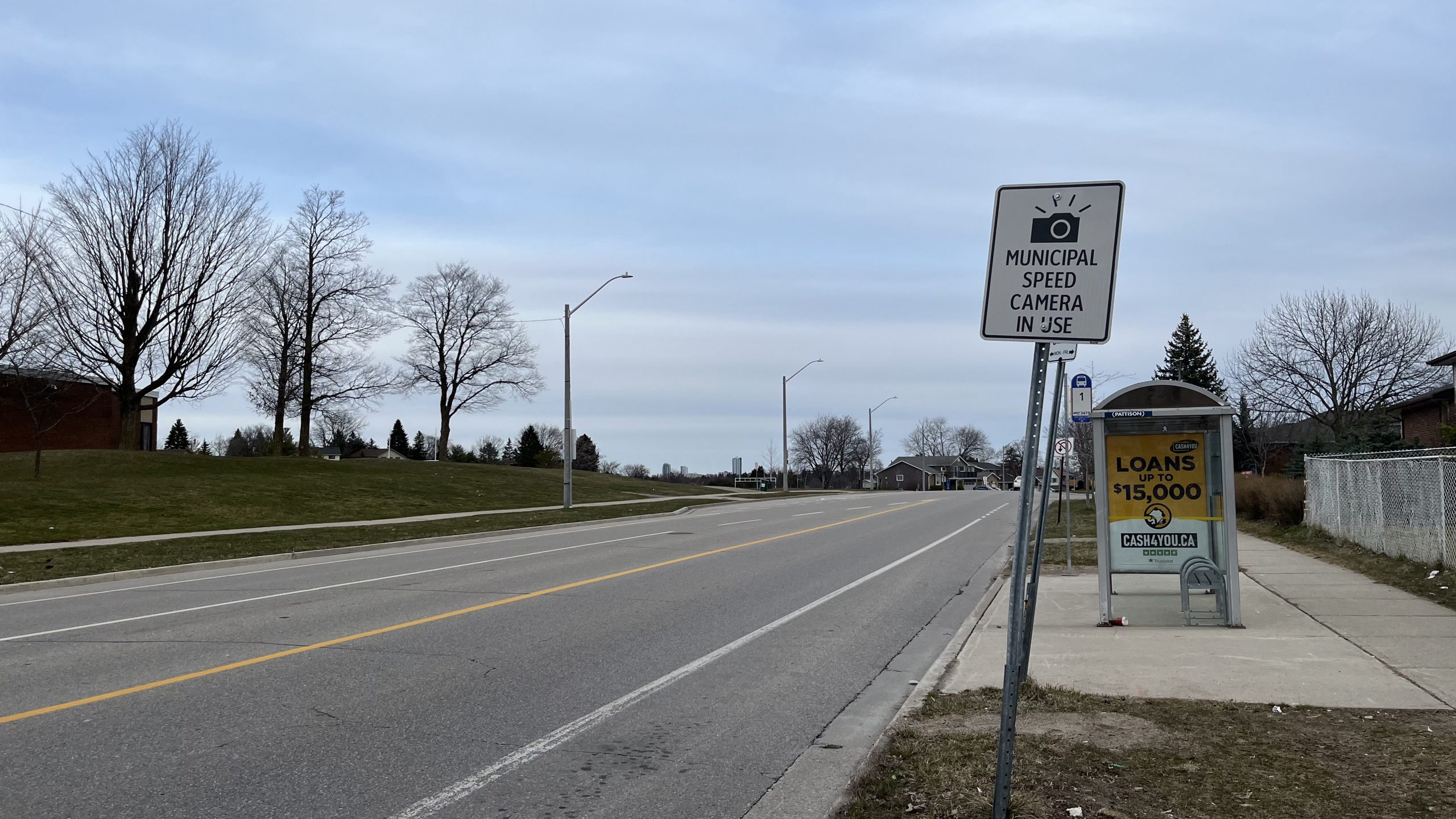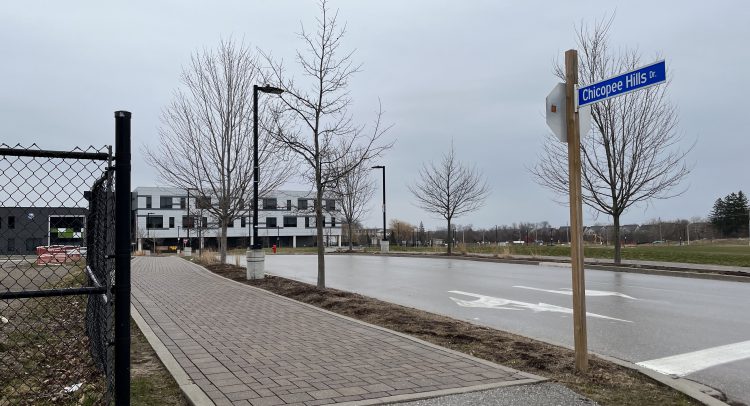SCHOOL ZONES ACROSS WATERLOO REGION ARE BECOMING SAFER WITH AUTOMATED SPEED CAMERAS.
By Leia Langridge
Lana Gudimenko has seen her share of close calls while walking her seven-year-old daughter to school in Kitchener. One morning, Gudimenko and her daughter stopped at the crosswalk on Lackner Boulevard near Chicopee Hills Public School in southeast Kitchener and looked both ways. A delivery truck stopped to let them cross, but the driver in the vehicle behind the truck wasn’t so patient. The vehicle swerved out from behind, crossed the solid yellow line dividing the two lanes and sped past the delivery truck and the crosswalk, near where Gudimenko and her daughter were waiting to cross.
“Thank God I decided to stop. Otherwise, he would have hit me and my daughter,” said Gudimenko.
Parents like Gudimenko are concerned with school zone safety across Waterloo Region. There have been near-misses like Gudimenko’s since Chicopee Hills was built in 2013. She wants the region to lower speed limits, forcing drivers to slow down to 40 km/hr at the curve before the crosswalk instead of the current 50 km/hr recommended speed. “That would help to even get those drivers to have an opportunity to stop. Because a lot of people know about the crosswalk, but some people may not know,” said Gudimenko.
The public school is on Chicopee Hills Drive, a private road near the busy intersection of Lackner Boulevard and Fairway Road. Along with a crossing guard at the intersection, there’s also a crosswalk further up Lackner by Corfield Drive, which leads into a residential neighbourhood where many students who attend Chicopee Hills live.

Nearly every student at the school lives within walking distance, though the school also has a Kiss n’ Ride lane parents use for drop off and pick up, adding to traffic around the school during those times.
Gudimenko’s story isn’t the only close call around the school.
In 2018, a crossing guard pulled a boy out of harm’s way when a van drove through the crosswalk, even though its flashing lights had been activated. Parents have long complained about the dangers of Lackner Boulevard and Fairway Road and the high-speed limits.
In 2021, Waterloo Region began addressing road safety concerns around some schools by dropping speed limits in school zones from 40 km/h or higher to 30 km/h. The region also installed automated speed cameras in the first eight school zones that summer, but Chicopee Hills wasn’t one of them. The cameras are in high-risk areas, such as in front of Westheights Public School, Franklin Public School and Sandhills Public School. A high-risk area is where a school is on a main road. Sandhills Public School for example is on Victoria Street, a high-traffic road that, according to road statistics the region tracks, is used by about 20,000 vehicles every day. Because Chicopee Hills is on its own private road, which bears the same as the school, the school is considered far enough away from Fairway and Lackner that it doesn’t warrant a change in speed limit.
The cost of change
Automated speed cameras aren’t cheap — the cameras will cost Waterloo Region $1.39 million in 2024, almost doubling every year until 2029 — but regional staff expect the cameras will bring in more money by that year.
Rob Deutschmann has been a personal injury lawyer in the region for 29 years. He said 80 per cent of his work deals with motor vehicle accident claims. Deutschmann is also a Waterloo regional councillor who’s been in office for a year now.
Deutschmann proposed the motion to expand the speed camera program in April 2023. The Region of Waterloo installed municipal speed camera set ups in 16 school zones across the Waterloo Region. Though the cameras are part of a separate program, the new 30 km/hr speed limit signs work with them to slow down traffic. The city has recently changed some speed limits back up to 40 km/h.
“We’re used to driving 50 and 60 and now if you’ve driven at a certain speed for 10, 15, 20 years, to go down to 30 might feel too slow,” said Deuschmann.
As a regional councillor, Deutschmann has long heard complaints from parents about how tricky it can be to walk to school.
Around Chicopee Hills for example, there isn’t a direct path from the residential streets near the housing development behind the school to the school’s grounds. Instead, parents and students must walk down Fairway Road and enter the school from the front or take a trail that’s equally as close to Fairway. Students who live on the other side of the Lackner and Fairway intersection cross the 60 km/hr streets at some of the busiest times of the day. “I think at one point, they [city developers] were hoping there would be some connection from these homes or this area in the back way through to the school. But it’s never come to fruition,” said Deutschmann.
How speed cameras work
Though the region is still tracking the results of the automated speed camera program, there are some early hints of its success — the region keeps adding automated speed cameras. It currently has 175 school zones and has plans to double the number of speed cameras every year.
But while the program seems to be working to slow drivers down around schools, there are some drawbacks. The cameras are expensive — in 2024 the program is expected to cost the region $1.39 million — so while there may be a box for a speed camera outside a school warning drivers about it, that doesn’t mean there’s an actual camera inside the box photographing speeding drivers, said Deutschmann. Instead, the region rotates the cameras between locations, he said.

Once a speeding vehicle passes the camera, it takes a photo and stores the information until it’s processed and confirmed. Automated speed cameras have three parts: a speed measurement mechanism, a data processing and storage drive, and a programmed camera to include the vehicle’s speed, time of day, location and license plate. Once the drive in the box is full, a regional employee takes it to a ticket processing centre where a police officer reviews the photos to confirm the offence. The person registered to the license plate will receive a ticket in the mail within 30 days — anywhere from $75 if a driver is caught speeding 20 km/hr over the posted speed limit to as high as $294 for someone caught driving 49 km/hr over the speed limit. Drivers travelling more than 50 km/hr over the speed limit must go to court.
The cameras have been so successful, the region wants to build a new ticket processing centre to handle all of the tickets the cameras have generated.
The region currently uses a ticket processing system in Toronto, which is at capacity. The system has a dedicated space for the Waterloo Region, along with other municipalities and cities in the surrounding area. But it can only process 70,000 tickets from the region. With the newly installed extra cameras in school zones, regional staff expects the cameras will generate 75,000 tickets a year and make a dent in road safety.
From 2016 to 2020, there were 543 pedestrian collisions in Waterloo Region — 67 in 2020 alone. In more than half of those collisions, the pedestrian had the right-of-way. It was the same story in 2018. Of the 110 collisions recorded with pedestrians that year, pedestrians had the right of way in 58 per cent of them.
Road safety strategies getting international attention
Waterloo Region isn’t the only place in Canada tackling road safety. Across Canada, more and more municipalities are turning to speed cameras to enforce speed limits and slow down drivers.
According to ASE Ontario, in 2016, Quebec reported average speeds dropped 13.3 km/hr and crashes were cut between 15 to 42 per cent in areas with a speed camera. An evaluation of Saskatchewan’s pilot speed camera program saw a 17 per cent reduction in vehicle speeds and a 63 per cent decrease in speed-related crashes with injuries. The pilot program also resulted in 51 per cent fewer injuries in the province.
But changing speed limits isn’t the only way to slow drivers down, said Darryl Spencer, the manager of transportation engineering for Waterloo Region. The region is also focusing on changing road design — a concept first introduced with a road safety campaign called Vision Zero.
In 1997, Sweden started Vision Zero, which aims to eliminate road deaths. Road deaths have decreased by about 85 per cent in Sweden since it rolled out its Vision Zero program. The campaign has since attracted international attention, and other cities have adopted similar strategies, including Waterloo Region, which created its own version of Vision Zero in 2019.
Faranak Hosseini leads the project in Kitchener and said that while the speed cameras are separate from Vision Zero, they’re an important part of road safety. Waterloo region’s Vision Zero plan is more focused on changing street design to slow cars — narrowing some busy roads and building separated bicycle lanes, for example — but the Vision Zero goal is the same as the one with speed cameras: to slow drivers down and make streets safer for all.
The City of Kitchener adopted a modified Vision Zero strategy in March 2020. The Vision Zero team in Kitchener found speeding was one of the top contributors to road-related injury or death. Since then, the city has focused on cutting speeding in spots where collisions occur most, such as busy roads and school zones as the school day begins and ends.
The Kitchener Vision Zero team created a list of all schools in the region and ranked them based on the most concerning and high-traffic areas. Then the team took the top 10 most concerning and the high-traffic areas and changed speed limits in the school zones. The team also began building separated bicycle lanes and speed bumps in residential neighbourhoods around the schools.
Kitchener’s Vision Zero dashboard includes a map of where the city is dropping road speeds to 40 km/hr. According to the map, Chicopee Hills Public School is in a completed section, but Lackner and Fairway still have a 60 km/hr posted speed limit.
Are the cameras working?
The City of Kitchener works with Waterloo regional police, the University of Waterloo, the region’s public health unit, the Student Transportation Services of Waterloo Region and the City of Waterloo to research and analyze collision data and enforce road safety. The Vision Zero team has a public dashboard keeping track of the progress of Vision Zero. It counts fatalities and injuries, both minor and significant.
But it’s hard to say whether the speed cameras have made regional roads safer as it takes time to analyze the results, said one researcher who’s helping the City of Kitchener crunch the numbers.
When there is a change made to improve road safety, researchers have to wait around five to 10 years to collect the data, said Reza Aminghafouri, a Ph.D. candidate in civil engineering of transportation at the University of Waterloo, who has worked on research for the City of Kitchener. After that, the region can compare the number of collisions before and after it introduced speed cameras and Vision Zero strategies, said Aminghafouri.
The region is also still testing the new cameras and that takes time, added Spencer.
“Automated Speed Enforcement has a lagging effect because it penalizes and, in a way, educates drivers only after they’ve already sped through a critical area,” said Spencer.
Though it’ll take years to analyze the data collected from the reduced speed limits in school and community zones to determine if they’ve effectively reduced traffic fatalities, Deutschmann isn’t convinced the region will ever fully eliminate road deaths. “I don’t think you’ll ever get to a point where there’ll be zero accidents, but you want to strive to continue to find safer road construction and design, adding things to existing roads that slow people down, like speed bumps or narrowing of the road,” he said.
In the meantime, parents like Gudimenko are focused on teaching their kids road safety skills.
She said she’s been teaching her daughter to look both ways before crossing streets daily. “Every day when I take her [to school], she’s like, ‘Mom, I know I know,’ but I’m going to say it anyway.”

